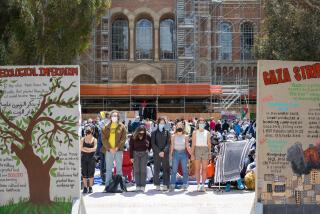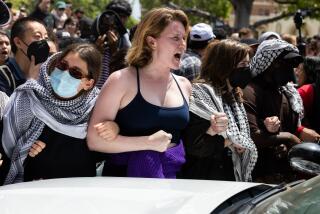Protests, 1980s’ Style: Cooperation Replaces Tear Gas and Night Sticks
- Share via
WASHINGTON — Police described the crowd as peaceful, visitors praised the courtesy of the officers, and everyone considered the event a success. This is protest, 1980s’ style.
In another decade, tear gas and night sticks might have been used against the several hundred demonstrators arrested two months ago as they tried to block access to Central Intelligence Agency headquarters in suburban Virginia.
And in fact, on May Day 17 years ago, police did resort to those tactics to thwart thousands of anti-war protesters bent on shutting down the capital city.
But that was before today’s era of good feeling and planning, of congenial handshakes and media accommodation, of politeness so pervasive that some veterans wonder if protests haven’t lost their flavor.
Spontaneity Lost
“You tend to lose some of the spontaneity, some of that surprise element, when there’s so much cooperation with the local authorities,” says Rep. John Lewis (D-Ga.), who suffered beatings, jailings and other hardships in leading civil rights protests throughout the South.
Not all demonstrators are nostalgic about encounters past. “I’d just as soon rather not get my head split open,” says longtime anti-war activist Abbie Hoffman. Last April, he was acquitted with Amy Carter and others of charges stemming from a sit-in against CIA recruiting at the University of Massachusetts in Amherst.
Head splitting is unlikely in the new age of protest, when demonstrators and their lawyers normally meet several times before D-Day with the police and their lawyers to discuss who will be where to get arrested when.
“We know what’s going to happen nine out of 10 times,” says Mickey McQueenie, a deputy chief of the U.S. Park Police.
Negotiation Is Best
“It’s in everyone’s interest to negotiate,” says Rick Robbins, the Park Police’s permanent solicitor. “Demonstrators and the police are less likely to get hurt. And the planning for both sides facilitates the news coverage. Spontaneous violence doesn’t often get covered very well.”
Protests are now so routine that the Park Police issues press releases on arrests at the White House. Local cops sometimes seek autographs from famous demonstrators. Ragtag peace marchers hand out computerized press kits. The rich and celebrated sleep on grates with the homeless and picket week after week outside the South African Embassy. Parents support their children’s causes; college students seek protest tips from ex-activist faculty members.
Line Is Fading
Whatever happened to the line between the Establishment and the Anti-Establishment? Consider:
- On the same April weekend that spring college celebrations turned violent in Colorado and California, prompting scores of arrests, 75,000 people came to Washington to protest U.S. policies in Central America and South Africa--and only one person was arrested. Two days later, at the CIA protest, police arrested 553 people without incident. The demonstrators were well-meaning and peaceful, a police official commented later.
- When the Great Peace March straggled into the nation’s capital last fall at the end of an exhausting cross-country walk, it was preceded by a press bus spewing computer-generated facts for national consumption: number of marchers, number of states and nations represented, number of children, senior citizens and international marchers, number of coast-to-coasters, number of births, deaths and marriages, oldest marcher, youngest marcher, male-female ratio.
- Arm-banded “peacekeepers” at a small protest against Central American policy, anticipating violence from counterdemonstrators, carefully trained marshals to “handle anger, anybody’s anger.” But the only anger they evoked was from a motorist trying to make a right turn across the march route.
‘A Sense of Fear’
Veteran police and protesters remember far more threatening encounters.
“We all thought we were going to get wiped out the next morning. There was a certain feeling that we were on the brink of the apocalypse,” says Hoffman, one of the “Chicago Seven” arrested nearly 20 years ago in violent demonstrations outside the national Democratic convention. “Now students are panicked by the economic situation. They perceive that if they don’t get that diploma they’ll fall off the edge of the free world.”
Lewis, who led civil rights protests as chairman of the Student Nonviolent Coordinating Committee, says, “It was like taking your life in your own hands. When we crossed the Georgia line and got into Alabama, a sense of fear came over us. When we left Alabama to go to Mississippi, there was another degree of fear. It intensified. You had this eerie feeling. But now I don’t even think about it when I go to Mississippi or Alabama. You just don’t even think about it.”
The cops have their own tales to tell. “I’ve been hit with bottles and bricks and rocks,” says Robert Langston, now a deputy chief of the park police. “I can remember apples and potatoes that were thrown at us that had nails sticking through them. . . . They were using oven cleaner--lye.”
Canned Goods Thrown
The most violent demonstrations of the period were the anti-war protests, while civil rights events such as Resurrection City in 1968 were generally peaceful. But even the calm protests were marred at times by violent splinter groups.
“I recall people who were in Resurrection City throwing canned goods at us that were donated to them by the do-gooders--the church groups,” McQueenie says.
He laughs wryly at that now, but the 1960s and early 1970s were a trying and tiring period for police officers--the most visible symbols of the government that had inspired so much bitterness and anger.
“It seemed like you could never go home. We used to send horses back to the stable and ship them back an hour later,” says Denis Ayres, who was in charge of the mounted contingent of U.S. Park Police. “At one time it didn’t ever look like there was an end to the buses coming into the city. In that period, you could have something billed as a rock concert that was in fact a demonstration. It was pretty bitter in those times.”
Protesters Have Changed
The same demonstrators who hurled bottles and bricks at the police were very concerned about not hurting the horses, Ayres recalls. “At the end of the day people would pet the horse and ask its name. They felt it wasn’t the horse’s fault he was there.”
Hoffman, involved now in anti-CIA activity, says the split between police and demonstrators in the 1960s and early 1970s stemmed from labor unions being “very gung-ho on Vietnam. We knew we couldn’t get the Archie Bunkers so we went for the kids. That split doesn’t exist today. It’s very out of step to call policemen ‘pigs.’ Now you see them as other workers doing their jobs.”
The demonstrators have changed in other ways too, several police officers observe. They don’t have as much passion or money, and they lack the strong national leadership and organization provided in earlier times by groups such as Students for a Democratic Society.
Violent protests of the 1980s tend to involve Iranians and other foreign groups. Most domestic protests are small and relatively tame, the demonstrators older and more sophisticated than the angry students who preceded them on the streets: white-coated doctors against nuclear war, suited government officials against apartheid, cross-bearing clergy against U.S. policy in Central America.
No Bags of Rocks
If only 10% of a crowd was wearing gas masks during the 1960s and 1970s, says solicitor Robbins, “We’d say, ‘This is going to be OK.’ Now, you never see people wearing gas masks. People aren’t carrying bags of rocks.”
The Park Police oversee the monuments, parks and highways most often used for protests and have continued to hone their methods of handling demonstrations. They arrange not only for portable toilets, drinking fountains and ambulances, but for sufficient paddy wagons, jail cells and officers to handle whatever number of arrests are planned. Protest leaders ride in police escort cars. Few people if any are shoved around.
“The police have matured,” says retired Park Police Chief Jerry Wells. “They have learned from the past. If somebody wants to get arrested, there’s no use making any more problem out of it than is necessary.”
Complicated new rules and regulations make it harder to get arrested these days than 20 years ago, creating dilemmas for some protesters who can’t decide how far to go.
Few Arrests
For example, a dozen young religious workers knelt last summer on the steaming sidewalk in front of the White House, protesting what one called “the expense of war when the poor are being dispossessed.” But, it seemed, merely praying in a circle was not enough to get arrested; a pleasant cop informed them they would have to block the sidewalk or hold a banner directly in front of the White House.
“For me, getting arrested is not the pre-eminent reason I’m here. I came to pray,” said one demonstrator. “We came to do an act of civil disobedience,” countered another.
More to Read
Sign up for Essential California
The most important California stories and recommendations in your inbox every morning.
You may occasionally receive promotional content from the Los Angeles Times.













